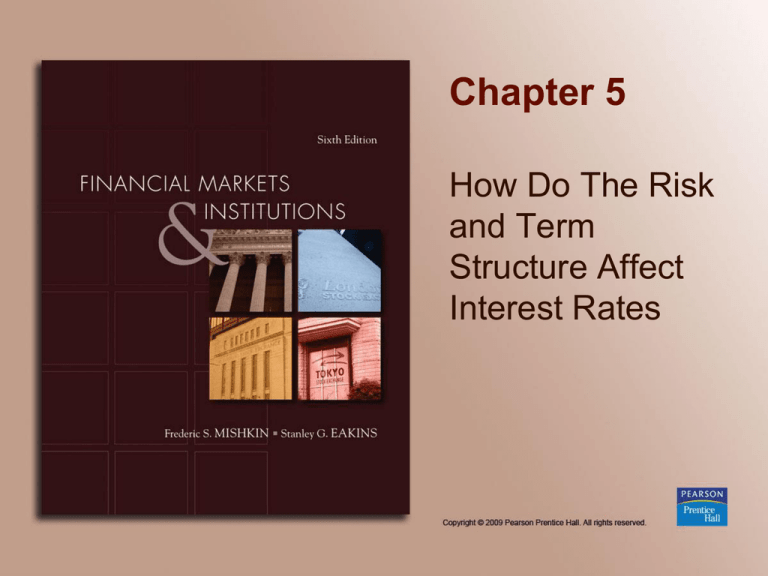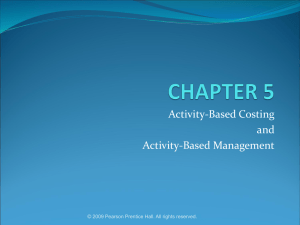
Chapter 5
How Do The Risk
and Term
Structure Affect
Interest Rates
Chapter Preview
In the last chapter, we examined interest
rates, but made a big assumption – there is
only one economy-wide interest rate. Of
course, that isn’t really the case.
In this chapter, we will examine the
different rates that we observe for financial
products.
Copyright © 2009 Pearson Prentice Hall. All rights reserved.
5-2
Chapter Preview
We will fist examine bonds that offer similar
payment streams but differ in price. The
price differences are due to the risk
structure of interest rates. We will
examine in detail what this risk structure
looks like and ways to examine it.
Copyright © 2009 Pearson Prentice Hall. All rights reserved.
5-3
Chapter Preview
Next, we will look at the different rates
required on bonds with different maturities.
That is, we typically observe higher rates
on longer-term bonds. This is known as
the term structure of interest rates. To
study this, we usually look at Treasury
bonds to minimize the impact of other risk
factors.
Copyright © 2009 Pearson Prentice Hall. All rights reserved.
5-4
Chapter Preview
• So, in sum, we will examine how the
individual risk of a bond affects its required
rate. We also explore how the general
level of interest rates varies with the
maturity of the debt instruments. Topics
include:
– Risk Structure of Interest Rates
– Term Structure of Interest Rates
Copyright © 2009 Pearson Prentice Hall. All rights reserved.
5-5
Risk Structure of Interest Rates
• To start this discussion, we first examine
the yields for several categories of longterm bonds over the last 85 years.
• You should note several aspects regarding
these rates, related to different bond
categories and how this has changed
through time.
Copyright © 2009 Pearson Prentice Hall. All rights reserved.
5-6
Risk Structure
of Long Bonds in the U.S.
Copyright © 2009 Pearson Prentice Hall. All rights reserved.
5-7
Risk Structure
of Long Bonds in the U.S.
The figure show two important features of
the interest-rate behavior of bonds.
•
Rates on different bond categories
change from one year to the next.
•
Spreads on different bond categories
change from one year to the next.
Copyright © 2009 Pearson Prentice Hall. All rights reserved.
5-8
Factors Affecting Risk Structure
of Interest Rates
To further examine these features, we will
look at three specific risk factors.
•
Default Risk
•
Liquidity
•
Income Tax Considerations
Copyright © 2009 Pearson Prentice Hall. All rights reserved.
5-9
Default Risk Factor
• One attribute of a bond that influences its
interest rate is its risk of default, which occurs
when the issuer of the bond is unable or
unwilling to make interest payments when
promised.
• U.S. Treasury bonds have usually been
considered to have no default risk because the
federal government can always increase taxes
to pay off its obligations (or just print money).
Bonds like these with no default risk are called
default-free bonds.
Copyright © 2009 Pearson Prentice Hall. All rights reserved.
5-10
Default Risk Factor (cont.)
• The spread between the interest rates on bonds
with default risk and default-free bonds, called
the risk premium, indicates how much
additional interest people must earn in order to
be willing to hold that risky bond.
• A bond with default risk will always have a
positive risk premium, and an increase in its
default risk will raise the risk premium.
Copyright © 2009 Pearson Prentice Hall. All rights reserved.
5-11
Increase in Default Risk
on Corporate Bonds
Copyright © 2009 Pearson Prentice Hall. All rights reserved.
5-12
Analysis of Figure 5.2: Increase in
Default on Corporate Bonds
• Corporate Bond Market
1. Re on corporate bonds , Dc , Dc shifts left
2. Risk of corporate bonds , Dc , Dc shifts left
3. Pc , ic
• Treasury Bond Market
4. Relative Re on Treasury bonds , DT , DT shifts right
5. Relative risk of Treasury bonds , DT , DT shifts right
6. PT , iT
• Outcome
– Risk premium, ic - iT, rises
Copyright © 2009 Pearson Prentice Hall. All rights reserved.
5-13
Default Risk Factor (cont.)
• Default risk is an important component of the
size of the risk premium.
• Because of this, bond investors would like to
know as much as possible about the default
probability of a bond.
• One way to do this is to use the measures
provided by credit-rating agencies: Moody’s and
S&P are examples.
Copyright © 2009 Pearson Prentice Hall. All rights reserved.
5-14
Bond Ratings
Copyright © 2009 Pearson Prentice Hall. All rights reserved.
5-15
Liquidity Factor
• Another attribute of a bond that influences
its interest rate is its liquidity; a liquid asset
is one that can be quickly and cheaply
converted into cash if the need arises. The
more liquid an asset is, the more desirable
it is (higher demand), holding everything
else constant.
• Let’s examine what happens if a corporate
bond becomes less liquid (Figure 1 again).
Copyright © 2009 Pearson Prentice Hall. All rights reserved.
5-16
Decrease in Liquidity
of Corporate Bonds
Figure 5.2 Response to a Decrease in the Liquidity of Corporate Bonds
Copyright © 2009 Pearson Prentice Hall. All rights reserved.
5-17
Analysis of Figure 5.1: Corporate Bond
Becomes Less Liquid
• Corporate Bond Market
1. Liquidity of corporate bonds , Dc , Dc shifts left
2. Pc , ic
• Treasury Bond Market
1. Relatively more liquid Treasury bonds, DT , DT shifts right
2. PT , iT
• Outcome
–
Risk premium, ic - iT, rises
• Risk premium reflects not only corporate bonds' default
risk but also lower liquidity
Copyright © 2009 Pearson Prentice Hall. All rights reserved.
5-18
Liquidity Factor (cont.)
• The differences between interest rates on
corporate bonds and Treasury bonds (that
is, the risk premiums) reflect not only the
corporate bond’s default risk but its liquidity
too. This is why a risk premium is
sometimes called a risk and liquidity
premium.
Copyright © 2009 Pearson Prentice Hall. All rights reserved.
5-19
Income Taxes Factor
• An odd feature of Figure 1 is that municipal
bonds tend to have a lower rate than
Treasuries. Why?
• Munis certainly can default. Orange
County (California) is a recent example
from the early 1990s.
• Munis are not as liquid a Treasuries.
Copyright © 2009 Pearson Prentice Hall. All rights reserved.
5-20
Income Taxes Factor
• However, interest payments on municipal
bonds are exempt from federal income
taxes, a factor that has the same effect on
the demand for municipal bonds as an
increase in their expected return.
• Treasury bonds are exempt from state and
local income taxes, while interest payments
from corporate bonds are fully taxable.
Copyright © 2009 Pearson Prentice Hall. All rights reserved.
5-21
Income Taxes Factor
• For example, suppose you are in the 35%
tax bracket. From a 10%-coupon Treasury
bond, you only net $65 of the coupon
payment because of taxes
• However, from an 8%-coupon muni, you
net the full $80. For the higher return, you
are willing to hold a riskier muni (to a point).
Copyright © 2009 Pearson Prentice Hall. All rights reserved.
5-22
Tax Advantages of Municipal Bonds
Copyright © 2009 Pearson Prentice Hall. All rights reserved.
5-23
Analysis of Figure 5.3:
Tax Advantages of Municipal Bonds
• Municipal Bond Market
1. Tax exemption raises relative Re on municipal
bonds,
Dm , Dm shifts right
2. Pm
• Treasury Bond Market
1. Relative Re on Treasury bonds , DT , DT shifts left
2. PT
• Outcome
im < iT
Copyright © 2009 Pearson Prentice Hall. All rights reserved.
5-24
Term Structure of Interest Rates
Now that we understand risk, liquidity, and
taxes, we turn to another important
influence on interest rates – maturity.
Bonds with different maturities tend to have
different required rates, all else equal.
Copyright © 2009 Pearson Prentice Hall. All rights reserved.
5-25
The WSJ: Following the News
For example, the WSJ publishes a plot of
the yield curve (rates at different
maturities) for Treasury securities.
The picture on page 107 of your text is a
typical example, from May 14, 2007.
What is the 3-month rate? The two-year
rate?
Copyright © 2009 Pearson Prentice Hall. All rights reserved.
5-26
Term Structure Facts to Be Explained
Besides explaining the shape of the yield
curve, a good theory must explain why:
• Interest rates for different maturities
move together. We see this on the next
slide.
Copyright © 2009 Pearson Prentice Hall. All rights reserved.
5-27
Interest Rates on Different Maturity
Bonds Move Together
Copyright © 2009 Pearson Prentice Hall. All rights reserved.
5-28
Term Structure Facts to Be Explained
Besides explaining the shape of the yield
curve, a good theory must explain why:
• Interest rates for different maturities
move together.
• Yield curves tend to have steep upward
slope when short rates are low and
downward slope when short rates are high.
• Yield curve is typically upward sloping.
Copyright © 2009 Pearson Prentice Hall. All rights reserved.
5-29
Three Theories of Term Structure
1. Expectations Theory
–
Pure Expectations Theory explains 1 and 2,
but not 3
2. Market Segmentation Theory
–
Market Segmentation Theory explains 3, but not 1
and 2
3. Liquidity Premium Theory
–
Solution: Combine features of both Pure
Expectations Theory and Market Segmentation
Theory to get Liquidity Premium Theory and explain
all facts
Copyright © 2009 Pearson Prentice Hall. All rights reserved.
5-30
Expectations Theory
• Key Assumption: Bonds of different
maturities are perfect substitutes
• Implication: Re on bonds of different
maturities are equal
Copyright © 2009 Pearson Prentice Hall. All rights reserved.
5-31
Expectations Theory
To illustrate what this means, consider two
alternative investment strategies for a twoyear time horizon.
1. Buy $1 of one-year bond, and when it
matures, buy another one-year bond with
your money.
2. Buy $1 of two-year bond and hold it.
Copyright © 2009 Pearson Prentice Hall. All rights reserved.
5-32
Expectations Theory
The important point of this theory is that if
the Expectations Theory is correct, your
expected wealth is the same (at the start)
for both strategies. Of course, your actual
wealth may differ, if rates change
unexpectedly after a year.
We show the details of this in the next few
slides.
Copyright © 2009 Pearson Prentice Hall. All rights reserved.
5-33
Expectations Theory
• Expected return from strategy 1
(1 it )(1 i ) 1 1 it i
e
t 1
e
t 1
it (i ) 1
e
t 1
Since it(iet+1) is also extremely small,
expected return is approximately
it + iet+1
Copyright © 2009 Pearson Prentice Hall. All rights reserved.
5-34
Expectations Theory
• Expected return from strategy 2
(1 i2t )(1 i2t ) 1 1 2(i2t ) (i2t )2 1
Since (i2t)2 is extremely small, expected return is approximately
2(i2t)
Copyright © 2009 Pearson Prentice Hall. All rights reserved.
5-35
Expectations Theory
• From implication above expected returns of two
strategies are equal
• Therefore
2i2t it i
e
t 1
Solving for i2t
it i
i2t
2
e
t 1
Copyright © 2009 Pearson Prentice Hall. All rights reserved.
(1)
5-36
Expectations Theory
• To help see this, here’s a picture that
describes the same information:
Copyright © 2009 Pearson Prentice Hall. All rights reserved.
5-37
More generally for n-period bond…
int
it it 1 it 2 ... it n1
n
(2)
• Don’t let this seem complicated. Equation
2 simply states that the interest rate on a
long-term bond equals the average of short
rates expected to occur over life of the
long-term bond.
Copyright © 2009 Pearson Prentice Hall. All rights reserved.
5-38
More generally for n-period bond…
• Numerical example
– One-year interest rate over the next five years
are expected to be 5%, 6%, 7%, 8%, and 9%
• Interest rate on two-year bond today:
(5% + 6%)/2 = 5.5%
• Interest rate for five-year bond today:
(5% + 6% + 7% + 8% + 9%)/5 = 7%
• Interest rate for one- to five-year bonds today:
5%, 5.5%, 6%, 6.5% and 7%
Copyright © 2009 Pearson Prentice Hall. All rights reserved.
5-39
Expectations Theory
and Term Structure Facts
• Explains why yield curve has different slopes
1. When short rates are expected to rise in future,
average of future short rates = int is above today's
short rate; therefore yield curve is upward sloping.
2. When short rates expected to stay same in future,
average of future short rates same as today's, and
yield curve is flat.
3. Only when short rates expected to fall will yield curve
be downward sloping.
Copyright © 2009 Pearson Prentice Hall. All rights reserved.
5-40
Expectations Theory
and Term Structure Facts
• Pure expectations theory explains fact 1—
that short and long rates move together
1. Short rate rises are persistent
2. If it today, iet+1, iet+2 etc.
average of future rates int
3. Therefore: it int
(i.e., short and long rates move together)
Copyright © 2009 Pearson Prentice Hall. All rights reserved.
5-41
Expectations Theory
and Term Structure Facts
• Explains fact 2—that yield curves tend to have
steep slope when short rates are low and
downward slope when short rates are high
1. When short rates are low, they are expected to rise
to normal level, and long rate = average of future
short rates will be well above today's short rate;
yield curve will have steep upward slope.
2. When short rates are high, they will be expected to
fall in future, and long rate will be below current
short rate; yield curve will have downward slope.
Copyright © 2009 Pearson Prentice Hall. All rights reserved.
5-42
Expectations Theory
and Term Structure Facts
• Doesn't explain fact 3—that yield curve
usually has upward slope
– Short rates are as likely to fall in future as rise,
so average of expected future short rates will
not usually be higher than current short rate:
therefore, yield curve will not usually
slope upward.
Copyright © 2009 Pearson Prentice Hall. All rights reserved.
5-43
Market Segmentation Theory
• Key Assumption:
Bonds of different maturities are
not substitutes at all
• Implication:
Markets are completely segmented;
interest rate at each maturity are
determined separately
Copyright © 2009 Pearson Prentice Hall. All rights reserved.
5-44
Market Segmentation Theory
• Explains fact 3—that yield curve is usually
upward sloping
– People typically prefer short holding periods and thus have
higher demand for short-term bonds, which have higher
prices and lower interest rates than long bonds
• Does not explain fact 1or fact 2 because it
assumes long-term and short-term rates are
determined independently.
Copyright © 2009 Pearson Prentice Hall. All rights reserved.
5-45
Liquidity Premium Theory
• Key Assumption:
Bonds of different maturities
are substitutes, but are not
perfect substitutes
• Implication:
Modifies Pure Expectations
Theory with features of Market
Segmentation Theory
Copyright © 2009 Pearson Prentice Hall. All rights reserved.
5-46
Liquidity Premium Theory
• Investors prefer short-term rather than long-term
bonds. This implies that investors must be paid
positive liquidity premium, int, to hold long term
bonds.
Copyright © 2009 Pearson Prentice Hall. All rights reserved.
5-47
Liquidity Premium Theory
• Results in following modification of Expectations
Theory, where lnt is the liquidity premium.
int
it i
e
t 1
i
e
t2
... i
e
t n1
n
nt
(3)
• We can also see this graphically…
Copyright © 2009 Pearson Prentice Hall. All rights reserved.
5-48
Liquidity Premium Theory
Copyright © 2009 Pearson Prentice Hall. All rights reserved.
5-49
Numerical Example
1. One-year interest rate over the next five
years: 5%, 6%, 7%, 8%, and 9%
2. Investors' preferences for holding shortterm bonds so liquidity premium for oneto five-year bonds: 0%, 0.25%, 0.5%,
0.75%, and 1.0%
Copyright © 2009 Pearson Prentice Hall. All rights reserved.
5-50
Numerical Example
• Interest rate on the two-year bond:
0.25% + (5% + 6%)/2 = 5.75%
• Interest rate on the five-year bond:
1.0% + (5% + 6% + 7% + 8% + 9%)/5 = 8%
• Interest rates on one to five-year bonds:
5%, 5.75%, 6.5%, 7.25%, and 8%
• Comparing with those for the pure expectations
theory, liquidity premium theory produces yield
curves more steeply upward sloped
Copyright © 2009 Pearson Prentice Hall. All rights reserved.
5-51
Liquidity Premium Theory:
Term Structure Facts
• Explains All 3 Facts
– Explains fact 3—that usual upward sloped
yield curve by liquidity premium for
long-term bonds
– Explains fact 1 and fact 2 using same
explanations as pure expectations theory
because it has average of future short rates as
determinant of long rate
Copyright © 2009 Pearson Prentice Hall. All rights reserved.
5-52
Market
Predictions
of Future
Short Rates
Evidence on the Term Structure
• Initial research (early 1980s) found little
useful information in the yield curve for
predicting future interest rates.
• Recently, more discriminating tests show
that the yield curve has a lot of information
about very short-term and long-term rates,
but says little about medium-term rates.
Copyright © 2009 Pearson Prentice Hall. All rights reserved.
5-54
Case: Interpreting Yield Curves
• The picture on the next slide illustrates
several yield curves that we have observed
for U.S. Treasury securities in recent years.
• What do they tell us about the public’s
expectations of future rates?
Copyright © 2009 Pearson Prentice Hall. All rights reserved.
5-55
Case: Interpreting Yield Curves, 1980–
2008
Copyright © 2009 Pearson Prentice Hall. All rights reserved.
5-56
Case: Interpreting Yield Curves
• The steep downward curve in 1981
suggested that short-term rates were
expected to decline in the near future. This
played-out, with rates dropping by 300 bps
in 3 months.
• The upward curve in 1985 suggested a rate
increase in the near future.
Copyright © 2009 Pearson Prentice Hall. All rights reserved.
5-57
Case: Interpreting Yield Curves
• The slightly upward slopes in the remaining
years can be explained by liquidity
premiums. Short-term rates were stable,
with longer-term rates including a liquidity
premium (explaining the upward slope).
Copyright © 2009 Pearson Prentice Hall. All rights reserved.
5-58
Mini-case: The Yield Curve as a
Forecasting Tool
• The yield curve does have information
about future interest rates, and so it should
also help forecast inflation and real output
production.
– Rising (falling) rates are associated with
economic booms (recessions) [chapter 4].
– Rates are composed of both real rates and
inflation expectations [chapter 3].
Copyright © 2009 Pearson Prentice Hall. All rights reserved.
5-59
The Practicing Manager: Forecasting Interest
Rates with the Term Structure
• Pure Expectations Theory: Invest in 1-period bonds
or in two-period bond
1 it 1 ite1 1 1 i2t 1 i2t 1
Solve for forward rate, iet+1
1 i2t
2
e
t 1
i
1 it
1
(4)
Numerical example: i1t = 5%, i2t = 5.5%
ite1
1 0.055 2
1 0.05
Copyright © 2009 Pearson Prentice Hall. All rights reserved.
1 0.06 6%
5-60
Forecasting Interest Rates
with the Term Structure
• Compare 3-year bond versus 3 one-year bonds
1 it 1 ite1 1 ite2 1 1 i3t 1 i3t 1 i3t 1
Using iet+1 derived in (4), solve for iet+2
1 i3t
2 1
1 i2t
3
e
t 2
i
Copyright © 2009 Pearson Prentice Hall. All rights reserved.
5-61
Forecasting Interest Rates
with the Term Structure
• Generalize to:
1 in1t
n
1 int
n 1
e
t n
i
1
(5)
Liquidity Premium Theory: int = same as pure
expectations theory; replace int by int in (5)
to get adjusted forward-rate forecast
1 in1t n 1t
n
1 int nt
n1
e
t n
i
Copyright © 2009 Pearson Prentice Hall. All rights reserved.
1
(6)
5-62
Forecasting Interest Rates
with the Term Structure
• Numerical Example
2t = 0.25%, 1t=0, i1t=5%, i2t = 5.75%
2
1
0.0575
0.0025
e
it 1
1 0.06 6%
1 0.05
Example: 1-year loan next year
T-bond + 1%, 2t = .4%, i1t = 6%, i2t = 7%
2
1
0.07
0.004
e
it 1
1 0.072 7.2%
1 0.06
Loan rate must be > 8.2%
Copyright © 2009 Pearson Prentice Hall. All rights reserved.
5-63






